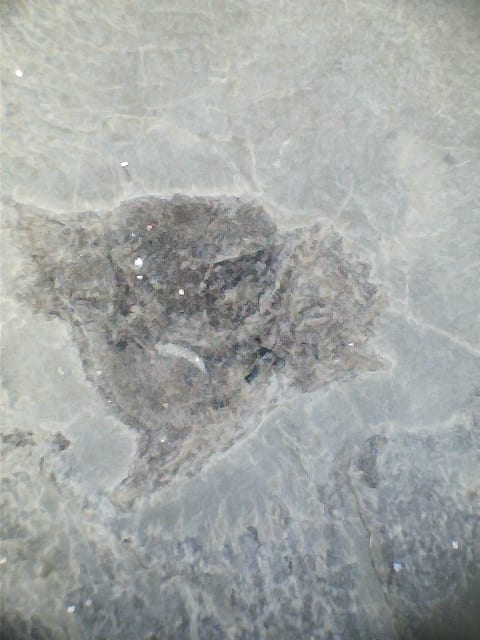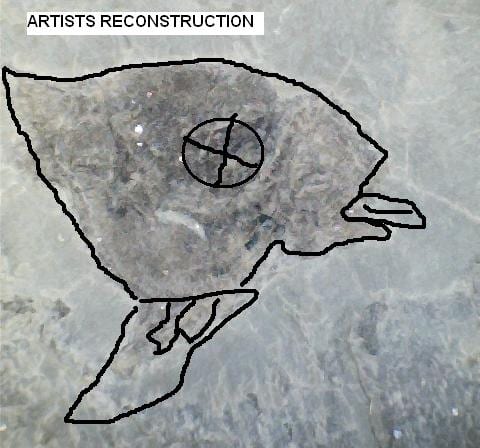Underwhelming Fossil Fish of the Month: April 2014
By Mark Carnall, on 29 April 2014
Underwhelming fossil fish: the final frontier. These are the voyages of the monthly underwhelming fossil fish blog. Its mission: to explore strange forgotten fossils, to seek out the uninteresting and the frankly plain, to boldly go where no palaeontologist has gone for hundreds of years.
DO DO DOO DOO DO DO DOOOOOOO. DO DO DO DO DO DO DOOOOOOOO. Etc.
This month’s underwhelming fossil fish has nothing to do with Star Trek at all. I just always wanted to open a blog like that. This month’s fossil fish, umm fished out of the fossil fish drawers at the Grant Museum, is distinctly uninteresting if I say so myself. It’s only my commitment to the mission of shining the spotlight on underwhelming fossil fish specimens that got me through writing this one. I cried a single glistening tear for the fossil that time and everybody, probably quite rightly, forgot.
Here’s this month’s fossil. This chunk of rock could have been a rather nice kitchen tile or piece of patio. Sadly it’s rather ruined by the fossil. Now, instead of decorating a kitchen or supporting garden furniture this specimen sits in a museum. Unloved. Ungazed upon. Unused. UNTIL NOW.

Can I direct your attention to the brown bit in the middle? That’s LDUCZ-V941 Rhamphodopsis sp. that is.
This one’s not, how shall we say, much of a looker. You won’t find it emblazing rainbow erasers in a museum shop or on a postcard. Even an ironic postcard. According to the record for this specimen what we’re looking at is the head of a fish identified as Rhamphodopsis sp. A little note on taxonomy, when you see ‘sp.’ after a genus it means that the species is unknown. There are only two species in the genus Rhamphodopsis but the way to tell them apart is the length of the spines which for our isolated head isn’t possible. Which means this poor specimen will remain unspeciated sadly. Rhamphodopsis is a genus of ptyctodontid fish, a group of armoured fish distinct in the fact that they lack the bony armour typical of the bigger group they are a member of. I know, it’s very confusing being an armourless armoured fish but that’s why palaeontology is so beautifully nonsensical sometimes. This specimen was collected from Old Red Sandstone deposits in Edderton in Scotland so this fossil is around 380 million years old.
Preservation There’s not much too this fossil so I popped it under my perpetually disappointing but cheap USB microscope for a closer look.
You can just about discern what looks like the bony plates of the back of the head, the bony plates at the base of the fins and what sort of looks like the mouth. Possibly. If you squint and turn your head sideways. Here’s how an up and coming talented palaeoartist available for commissions, murals and T-shirts may reconstruct the fossil.
This specimen has not been preserved particularly well, the elements of the skull have been what palaeontologists call ‘discombobulated’.
Research These fish have been studied more than you might expect. Their unique position as unarmoured armoured fishes has been studied to try to determine how armoured fish, placoderms, evolved. Initially it was thought that these less armoured ptyctodonts evolved into more armoured fishes, however, it appears that the evolution wasn’t quite so straight forward and that fish like Rhamphodopsis isn’t necessarily ‘primitive’. Rhamphodopsis in particular has been of research interest as it’s one of the few good examples of sexual dimorphism in placoderm fishes. Male Rhamphodopsis had hook-like projections functionally similar to claspers in other fishes to anchor males to females for channeling semen from cloaca to cloaca. It’s for this reason that Rhamphodopsis is mentioned in the excellent popular science book, Dawn of the Deed: The Prehistoric Origins of Sex. Lastly, interesting to note is that these fish were first described by former Grant Museum curator D.M.S Watson in 1934 whilst he was here at UCL. Maybe this was one of the fossils he was looking at when he described the genus and later one of the species? Given that it’s a poorly preserved isolated head probably not. But it could be.
In Society According to an anonymous and potentially entirely fictitious source, even though Rhamphodopsis wasn’t described until 70 years after it was published, the dodo character in Alice’s Adventures in Wonderland was originally going to be a Rhamphodopsis. I’ve written perhaps the first Rhamphodopsis fan-fiction about this fact.
Rhamphodopsis: The little ptyctodontid that almost made it
Lewis Carroll sits opposite his editor who is finishing reading through the manuscript of Alice’s Adventures in Wonderland. Everyone is smoking. Lewis Carroll’s editor looks up from the manuscript, takes of his glasses and addresses Lewis “It’s good Lewis but this Rhamphodopsis character….”.
“Yes it’s bloody awful, I’ll change it to a dodo or something” Lewis offered casually.
“Yes. That’s a good idea” Reflected his editor.
THE END
Rhamphodopsis sp.
Preservation 2
Research 6
In Society 0.5
Underwhelmingness 9
Mark Carnall is the Curator of the Grant Museum of Zoology
5 Responses to “Underwhelming Fossil Fish of the Month: April 2014”
- 1
-
2
Ian Scott wrote on 9 May 2014:
Great blog Mark! Even for me – a keen observer of the insignificant – I’m impressed by the deep scholarship revealed in your commentary on the wee smudge in the middle of your Rock/Fish of the Month. It’s either that or a wonderful piece of imaginative writing.
-
3
Helen Chavez wrote on 16 May 2014:
Mark, if your blog is ever made into a wonderfully underwhelming TV series, have you thought about doing the thing as a roadshow? If so, come to Aberdeenshire. We have an entire bay full of decidedly underwhelming fossil fish. By roving about the country perusing underwhelming fossil fish, you could bring underwhelmingness to a new, more international level – and prove to the world that just because a fossil fish is underwhelming, doesn’t mean it isn’t interesting.
PS – we have some very depressed-looking fossil ammonites too, by the way.
-
5
Underwhelming Fossil Fish of the Month March 2017 | UCL Museums & Collections Blog wrote on 31 March 2017:

[…] fish not the goat/lion/snake monsters from mythology. You may remember Rhamphodopsis from April 2014’s underwhelming fossil fish of the month and I think you’ll agree this specimen is almost exactly as uninteresting. How very […]
 Close
Close




I’m not convinced it’s a fish. I think it could be a gremlin.